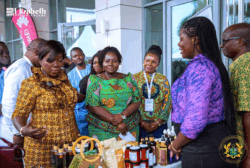Public Procurement forms an integral part of public money (funds) spent; budget is translated into services in a larger part through work of the public procurement system.
The construction of schools, bridges and roads, drilling wells, conservation of arable lands, factories, silos for the storage of grains, construction of buildings for workers, as well as the acquisition of medicine and textbooks, laboratory equipment, laptops and desktop computers, furniture occurs in most countries through the nation’s public systems.
Therefore, the ability of political leaders to meet their promises of economic and social improvement is closely related to how well public procurement is conducted.
The Public Procurement Authority (PPA) has launched a Ghana e-procurement system, dubbed the Ghana Electronic Procurement System (GHANEPS).
This singular effort made Ghana the first country in the West Africa sub-region to establish an electronic procurement system for the public.
The implementation is part of an e-transformational process being undertaken by government through the ministry of communication with funding support from the World Bank.
e-Procurement
e-Procurement, or electronic procurement, refers to the process of purchasing goods or services through electronic means; primarily through the Internet. It is an alternative to the manual/paper process of procurement, and it certainly surpasses the latter in many respects. Countries are increasingly opting for e-procurement platforms, realising their potential to curb irregularities and unnecessary cost in the procurement process.
In this regard, GHANEPS is important to the Public Procurement Authority and country as a whole.
Due to the importance of electronic procurement within our public procurement space, it has become a priority to ensure that GHANEPS’ implementation is executed efficiently to enable the nation reap all its benefits. GHANEPS supports processes of procuring Goods, Works, Consultancy, Non-Consultancy and disposal of assets. The system supports various public procurement procedures; including user registration, tender notification, tender preparation and submission, online tender evaluation, contract awarding, creation and management of catalogues, creation and management of framework agreements, auctions and payments.
Benefits of e-Procurement to the Public Sector
As an Authority, we are particularly driven by the inherent benefit of the system to transparency and restoration of public confidence in our public procurement system. For example, GHANEPS can tackle the malpractice of cartel formation to a great extent. It will ensure the safety of all information being provided by users. Data safety is at times compromised in the manual procurement process, and this e-platform is believed to do away with such occurrences.
GHANEPS provides an effective and efficient way of improving procurement while saving taxpayers money – all the more crucial as government faces increasing spending pressures. The use of online services for procurement activities gives wider participation to service providers, leading to increased competition. It also saves business-time by speeding up orders and delivery times, and is a more sustainable way of doing business for government.
Transparency is assured, as the evaluation and award process is conducted online with minimum human intervention. Information made available online by the e-procurement process enables interested parties – such as civil societies, suppliers, contractors, etc. – to instantly access information associated with each tender and award process.
Public entities, service providers and others are to take note that entities set up on GHANEPS are urged to conduct all the procurement via the system. This includes: Request for Quotation, National Competitive Tendering, International Competitive Tendering, Restrictive Tendering and Single Source.
PPA will cease to process manual applications and requests from entities which are set up on the system but are not active users of it.
Entities using GHANEPS will also not need to separately upload their procurement plan on the system, publish their tenders on PPA’s website, or publish their contract awarded on PPA’s website.
In conclusion, government is committed to its digitisation agenda – which is why GHANEPS has been introduced, all stakeholders acknowledge that effective change management with sufficient training and support of users is key to the of GHANEPS’ implementation. The procurement system has taken a new turn with the slogan ‘Emu da hƆ’










